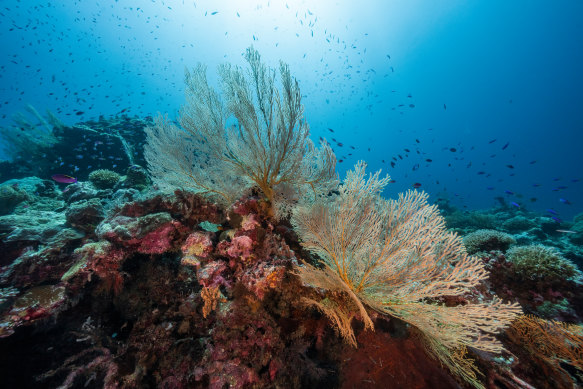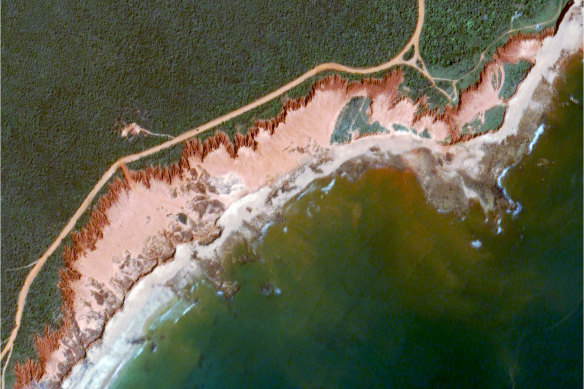By Peter Milne
Woodside is yet to apply for federal environmental approval for a key part of its $30 billon-plus Browse gas export project after its bid for a regulatory shortcut was rejected.
It is a setback for Woodside’s plan to develop the gas fields it discovered 51 years ago that already faces possible rejection by Western Australia’s environmental regulator, as it could affect blue whales’ feeding, destroy a nesting site for endangered turtles, or damage Scott Reef with an oil spill.

Federal environment minister Tanya Plibersek will decide whether Woodside’s plan to bury CO2 under the seabed is environmentally acceptable.Credit: Alex Westover and Wendy Mitchell / Greenpeace
In 2019, Australia’s largest oil and gas company lodged a proposal for Browse that included releasing up to 107 million tonnes of carbon dioxide from the gas fields into the atmosphere over the project’s lifetime.
Woodside told the federal environment regulator in a 2022 submission that capturing and storing the reservoir CO₂ was a “high-risk, high-cost” option that “remains technically challenging; however, with time, carbon capture and storage technology will improve”.
Less than a year later, Woodside requested its application include the injection of CO₂ underneath one of the Browse gas fields, arguing it was a minor change that did not need a separate assessment.
The Department of Climate Change, Energy, the Environment and Water rejected the move, telling Woodside in August 2023 the new proposal was “fundamentally different”.
One risk from carbon storage was CO₂ leaking from wells or under the seabed, making nearby water more acidic, according to the letter released after a freedom of information application.
“Successful carbon capture and storage programs in offshore environments are complex to execute because the technology is in its infancy,” the department said.
Another concern was that planned seismic testing, which would release high-pressure sound waves to measure the spread of the injected CO₂ under the seabed over decades, could injure or affect the behaviour of marine fauna, including endangered whales.
Conservation Council of WA director Jess Beckerling said carbon storage was “fantasy technology” that did not work, citing Chevron’s $3 billion attempt at WA’s Barrow Island, which after eight years works at one-third of its planned capacity.
“There has never been an offshore carbon dumping project in Australia, but Woodside is proposing to try this failed technology for the first time at the pristine Scott Reef,” she said.
In May, Woodside told the department it would refer carbon storage for assessment in mid-2024, according to meeting minutes released under another freedom of information request.
This would place carbon storage six years behind the rest of Browse in the environmental approval process, although the smaller scope could take less time to assess.
A Woodside spokesman said it was “working to progress an appropriate alternate pathway” to gain federal approval for carbon storage. Unlike other aspects of Browse, carbon storage does not need approval from the WA regulator as it is located outside state waters.
The WA Environmental Protection Authority, which told Woodside in February its preliminary view was that Browse was unacceptable, plans to release its final report in 2025.

Woodside Energy’s Browse project is off the coast of Broome. Credit: DigitalGlobe via Getty Images
Woodside chief executive Meg O’Neill wants three problems solved before committing to expensive engineering work required before Browse can go ahead: storing the reservoir CO₂, obtaining environmental approvals and a deal to process the gas into a liquid for export.
Woodside plans to pipe Browse gas 1000 kilometres to the ageing North West Shelf plant near Karratha; however, the two joint ventures have not yet struck a deal despite signing “non-binding preliminary agreements” in 2018.
Six years on, Woodside’s spokesman said the two joint ventures “are in negotiations … to agree key commercial terms”.
Woodside operates the Browse joint venture and has a 31 per cent stake. BP is the largest investor, with 44 per cent, and Japan Australia LNG and PetroChina also have a stake.
According to people familiar with the negotiations but not authorised to speak to the media, Chevron and Shell – both with equity in the North West Shelf but not Browse – are holding out for terms advantageous to the owners of the gas plant rather than the gas fields.
Woodside needs state and federal environmental approvals to extend the life of the North West Shelf plant to 2070 so it can process Browse gas.
The WA Environmental Protection Authority backed the extension in 2022 despite concluding nitrous oxide emissions from the plant “may be a threat of serious or irreversible damage” to the adjacent World Heritage-nominated Murujuga rock art.
The WA Appeals Convenor is expected to soon report on more than 700 appeals lodged against the EPA’s decision.
Woodside makes little mention of Browse in presentations to investors but argues it as a solution to a looming gas shortage in its home state.
“The single biggest opportunity to help meet WA’s domestic gas needs is Browse,” O’Neill said in May. “It’s really to underpin the WA economy … that’s a key message for us.”
Read more:
- WA public schools juggle almost 4000 demountables as numbers skyrocket
- Police charge pair over pursuit through Perth’s north-east
- Big emitters chase new climate fix: turning their pollution into products
The Business Briefing newsletter delivers major stories, exclusive coverage and expert opinion. Sign up to get it every weekday morning.